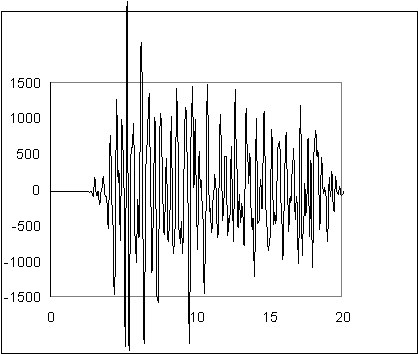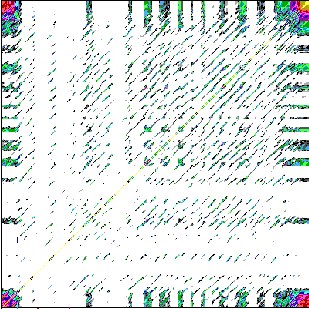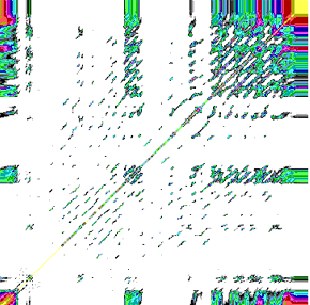Recurrence Quantification analysis and Transient Otoacoustic Emissions
Giovanna Zimatore
Giovanna.Zimatore@uniroma1.it
INTRODUCTION to RQA
The RECURRENCE QUANTIFICATION ANALYSIS (RQA) is a general-purpose tool developed over the last decade for the study of nonlinear dynamical systems. It is independent from various limiting constraints such as the data size, the data stationarity, and the assumptions regarding the statistical distribution of data (in most cases it is required that the data under analysis should have a normal distribution). Thus, it is ideally suited for physiological systems characterized by transients, state changes, and noise.
Fundamentals:
The RQA aims to a direct and quantitative description of the amount of deterministic structure of a signal. The basic idea behind RQA is the identification of recurrence of local data points in a reconstructed phase-space. The targeted system is analyzed by reconstructing the space of the true signal dynamics using a coordinate system of surrogate variables created by a combination of the measured signal and time-lagged copies of itself.
This coordinate system (embedding matrix, EM) is then transformed into a distance matrix by simply computing the euclidean distance between row (epochs) of the EM. An important aspect of the RQA analysis is the definition of: i) the embedding dimension for the deconvolution of the original signal in a multidimensional space, and ii) the radius (maximum euclidean distance at and below which the recurrent points are defined and displayed).
Each distance below the radius is considered a recurrence pair and the distance matrix is transformed into a recurrence plot by darkening all the recurrent points. (See Figure 1c,d).
To quantify the patterns appearing in recurrence plots the following descriptors are generally used:
- The percentage of recurrence (%REC), namely the percentage of the plot occupied by recurrent points.
The percentage of determinism (%DET), namely the percentage of recurrent points that appear in a sequence, forming diagonal line structures in the distance matrix. A line is a priori defined as the sequence which is equal to or longer than a predetermined threshold length. In the above context, the RADIUS parameter defines the distance below which two epochs are considered recurrent, and the %DET threshold defines the minimum number of consecutive recurrent points that can be scored as deterministic. The %DET corresponds to the number of patches of recurrent behavior in the studied series, i.e., to portions of the state space in which the system resides for a longer duration than expected by chance alone. It should be noted that theoretically a recurrence can be observed by chance whenever the system explores two nearby points of its state space. On the contrary, the observation of recurrent points consecutive in time which form lines parallel to the main diagonal, is an important signature of deterministic structuring.
- The entropy (ENT) is defined in terms of the Shannon-Weaver formula for information entropy computed over the distribution of length of the lines of recurrent points and measures the richness of deterministic structuring of the series.
Typical TEOAE signals from adult and newborn ears
A typical TEOAE signal from a newborn and the corresponding Recurrence Plot are reported in Figures (a) and (c), respectively. Figures (b) and (d) refer to an adult signal. For the RQA plots the following parameters were used : Emb=10, Radius=15, Lag=1, Line=8.
 Figure a: TEOAE response from a neonatal subject evoked by a nonlinear stimulus Figure a: TEOAE response from a neonatal subject evoked by a nonlinear stimulus Figure b: The RQA map from the TEOAE response of Figure a Figure b: The RQA map from the TEOAE response of Figure a Figure c: TEOAE response from an adult subject evoked by a nonlinear stimulus Figure c: TEOAE response from an adult subject evoked by a nonlinear stimulus Figure d: The RQA map from the TEOAE response of Figure c Figure d: The RQA map from the TEOAE response of Figure c
How to read a recurrence plot:
The recurrence map (RP)is a representation of the normalized distance between the points [x(i),x(i-m+1)]. If the two points are sufficiently closed to each-other, i.e. the distance is lower than a fixed cut-off value, a dot is plotted in the map.
Qualitative observations on the RP : - Single, isolated recurrence points reflect random, stochastic behavior.
- Short line segments parallel to the main diagonal, suggest that strings of vector patterns in the same time series repeat themselves multiple times over the observation period. This means that the dynamical processes are regulated by deterministic laws. White noise would not be aspect to show diagonal segments. The length of the segments is inversely proportional to the magnitude of the largest Lyapunov exponent of the signal and thus the maximum observed line length may itself be a measure of interest.
- Short line segments perpendicular to the main diagonal: vector sequences at different locations in the series are mirror images of one other, (this is aspect for simple oscillations such as a sine waves).
- Horizontal and vertical segments: isolated vector sequences match closely with a repeated string of vectors further along the dynamic.
- Bands of white space (no recurrent points) indicate transient activity or an abrupt level change, and may reflect an underlying change of state.
RQA and otocoustic emissions:
The specific application of RQA to the analysis of transient otoacoustic emissions under various conditions has been reported in the two following papers:
1. Giovanna Zimatore, Alessandro Giuliani, Calogero Parlapiano, Giorgio Grisanti, and Alfredo Colosimo.
Revealing Deterministic Structures in Click-Evoked OtoAcoustic Emissions.
J. Appl. Physiol.,(2000) 88, 1431-1437.
ABSTRACT
Click Evoked OtoAcoustic Emissions (TEOAEs) were studied by means of Recurrence Quantification Analysis (RQA) and found to be endowed with a relevant amount of deterministic structuring. Such a structure showed highly significant correlation with the clinical evaluation of the signal over a data set including 54 signals. Moreover: i) one of the RQA variables, TREND, showed very sensitive to phase transitions in the dynamical regime of TEOAEs, and ii) appropriate use of Principal Component Analysis proved able to isolate the individual character of the studied signals. These results are of general interest for the study of auditory signal transduction and generation mechanisms.
2.Giovanna Zimatore, Stavros Hatzopoulos , Alessandro Giuliani, Alessandro Martini, and Alfredo Colosimo
Comparison of Transient Otoacoustic Emission (TEOAE) responses from Neonatal and Adult Ears".
J. Appl. Physiol. (2002), in press.
ABSTRACT
TEOAE responses from neonatal (age: 48 hours) and adult subjects (age: 26.6±10.0 years) were analyzed by the combined use of Recurrence Quantification Analysis and Singular Value Decomposition. The data from the two age groups showed significant differences and similarities. The neonatal responses presented less deterministic structures than the adults, in terms of recurrent dynamical features. In both data sets the same high-level of individual-specific dynamical features was observed. The results from the Single Value Decomposition analysis suggest that a large percentage of variability in all the analyzed responses can be explained by 4 to 5 essential modes. This number is lower than that observed in simulated TEOAE responses generated by a 5-component gammatone model.
SOFTWARE
There is a FREE package (in DOS) developed by Charles Webber Jr. and Joseph P. Zbilut, which can be used to calculate and plot the RQA maps. The interested readers may download the package from the following address http://homepages.luc.edu/~cwebber/
|








